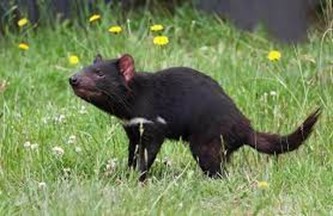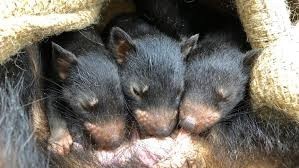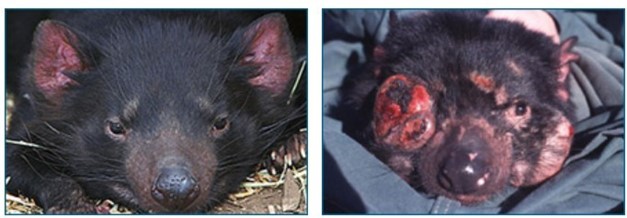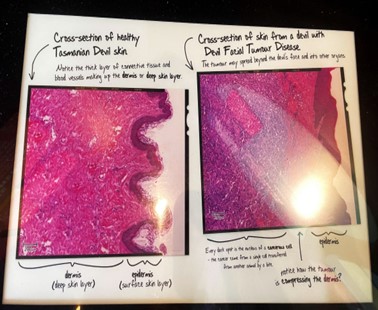by Clayton Thomas
What’s that on his face? . . . Oh yeah… It's cancer. Sarcophilus harrisii, commonly known as the Tasmanian Devil is the largest carnivorous (animal that eats meat) marsupial (animal with a pouch) in the world. Although these creatures look cute and cuddly, they can pack a treacherous bite. Tasmanian Devils are nocturnal, meaning they are active at night. They are considered scavengers that will eat any meat they may find. Their main source of food is carrion (animals they find that are already dead). Devils help play a crucial role in the ecosystem and help manage populations of other species. They are currently classified as an endangered species and without them, many other native species would be at risk as well.

THE CIRCLE OF LIFE
Tasmanian Devils will begin to mate around the age of 2 years old. Mating season typically begins in March and lasts until a female finds a mate. With devils, it is possible for one litter to have multiple fathers. Once pregnant, the gestation period lasts approximately 21 days. After gestation, a female can give birth to anywhere from 20-40 babies. These babies are the size of a grain of rice and have to “race to the finish line” in order to survive. As the babies are born, they must follow a saliva trail on the belly of their mom and crawl all the way into the pouch. This is a long journey for these tiny critters and so it is quite common for many to not survive. If they are lucky enough to survive the journey, they must fight to latch on to one of four teats in the pouch. The first four to latch on to a teat, will stay latched on for the next few months.
At around 4 months, the babies will begin to crawl out of the mother’s pouch and explore their den. The mother will often leave the babies in the den and come and go as she pleases. After the babies have grown large enough, they will start catching small invertebrates on their own and become fully weaned at around nine months of age. They will begin to learn how to play and find their place in their siblings' social circle. At this point in their life the young devils will start to disperse from home and begin creating their own dens.

A PAIN IN THE MASS
By observing the behavior of the Tasmanian Devil, it is no secret that biting is a part of their social behaviors. Biting can be a form of playfulness, used in a fight over food, the mating process, or even as a way to greet a fellow devil. Although this behavior is a normal part of life for Tasmanian Devils, it is also the cause of their population declining. For over 20 years Devils have been fighting off a deadly cancer that grows on their face known as Devil Facial Tumor Disease (DFTF). DFTF can easily spread between devils and is considered to be a highly contagious disease. Transmission occurs when a devil comes in contact with a devil who is already infected with cancer. This could be through a fight over, mating, or even just playing. As mentioned above, these are all common natural behaviors of this species.
The problem with this disease is that it affects the mouth and face of the animal and its cells rapidly multiply. DFTF has a low survival rate and most devils that become infected will die an extremely painful death in 6 to 12 months.

CHANGE IS ON THE HORIZON
Scientists and wildlife rehabilitators have been conducting research on this disease and have found an exciting discovery. Their research has found that Tasmanian Devils are beginning to breed at a younger age. They believe the critical link to flighting off DFTF genetically is breeding at a younger age. So far there are roughly 23 confirmed cases of DFTF that are in regression. This is great news for Tasmanian Devils, as it means that they are begging to save themselves! In an interview with a wildlife care giver at Bonorong Wildlife Sanctuary, he explained that the rehabilitation and release that they do is crucial to the devil populations. He later went on to say that they must also protect their resident devils from DFTF by implementing strict biosecurity practices. One of these practices being to euthanize any Tasmanian Devil that they find currently with DFTF. Although these may be other ways of dealing with an infected devil, euthanasia is the safest and most humane protocol to ensure the safety of the entire Tasmanian Devil species.
Key Takeaways
- Tasmanian Devil populations are declining because of a transmittable mouth cancer that can be extremely painful and deadly.
- Scientist have recently discovered that certain Devils are building a genetic resistance to the cancer and populations maybe starting to plateau.
- Due to habitat loss, Tasmanian Devils are even more at risk. Since this disease is spread through contact, Devils are being forced to live closer to other devils' habitat adding a greater risk of spreading the mouth cancer.

Sources
- Bonorong Wildlife Sanctuary: bonorong.com.au
- “Taronga Zoo Sydney.” Taronga Zoo Sydney | Taronga Conservation Society Australia https://taronga.org.au/sydney-zoo